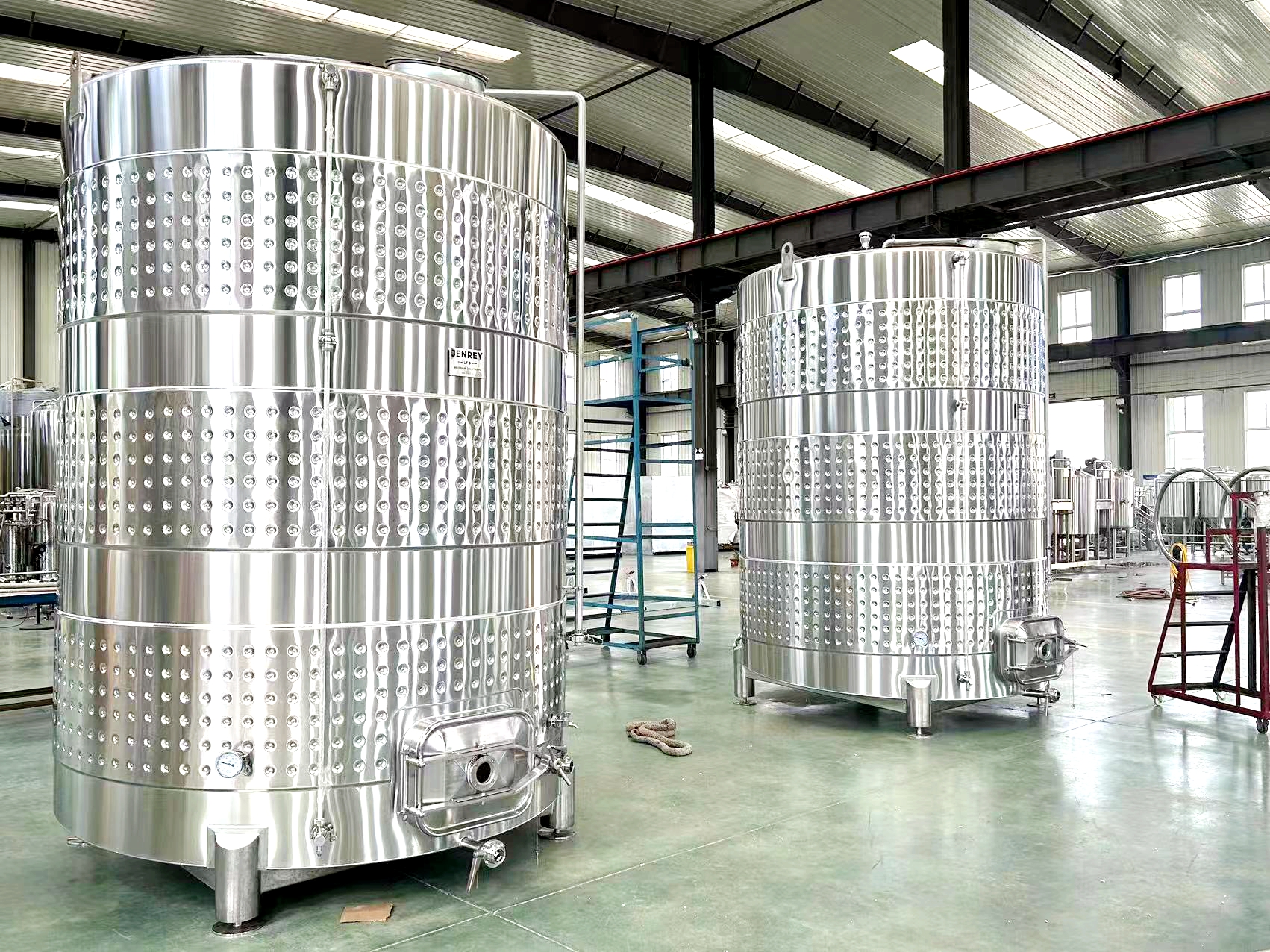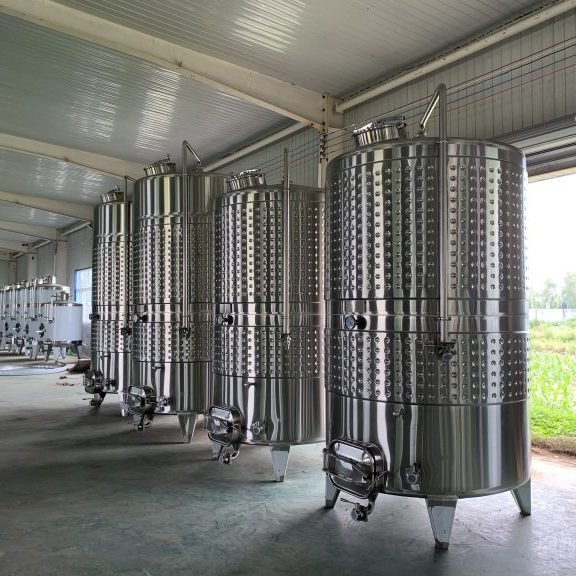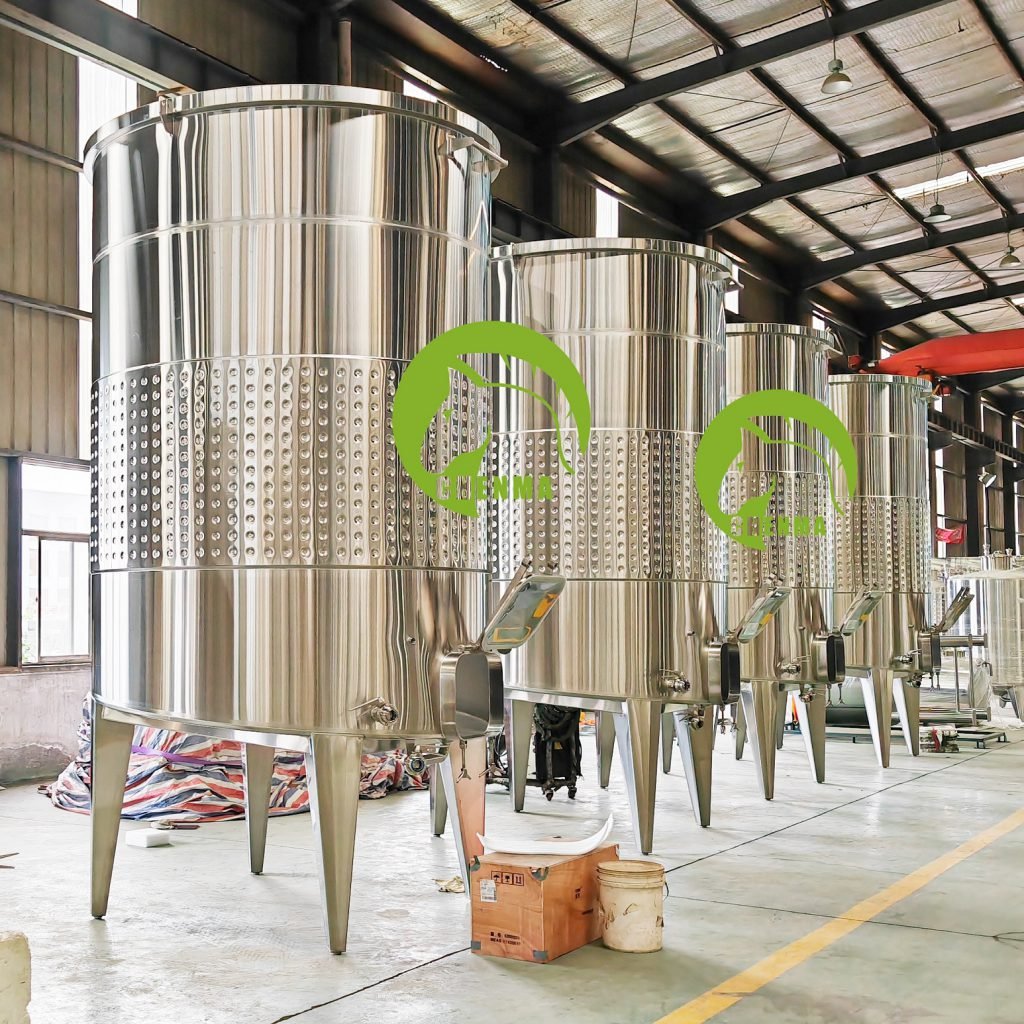
Stainless wine fermentation tanks have transformed winemaking by providing a durable and hygienic solution. These tanks resist corrosion due to the chromium and nickel content in their 304 and 316 stainless steel grades. This ensures their longevity even in challenging environments. Their exceptional thermal conductivity allows you to control fermentation temperatures with precision. Unlike traditional materials, stainless steel’s non-porous surface prevents contamination, maintaining the purity of your wine. With these advantages, you can achieve consistent, high-quality results while simplifying your workflow.
Chenma is one of the professional stainless steel wine tank manufacturers that can provide wineries with a variety of solutions. We also provide cider fermenter、variable capacity wine tank, ect.
The Importance of Stainless Wine Fermenters in Winemaking
How Stainless Steel Enhances the Fermentation Process
Stainless wine fermenters play a vital role in improving the wine fermentation process. These fermenters allow you to maintain precise temperature control, which is essential for producing high-quality wine. Built-in cooling jackets in stainless steel wine tanks help regulate the heat generated during fermentation. Without this control, excessive heat can lead to off-flavors or even halt the fermentation process entirely.
The airtight design of stainless steel tanks ensures that large volumes of must ferment efficiently. This feature is especially important for both red wine fermentation tanks and white wine fermentation tanks, as it helps preserve the integrity of the wine. Additionally, the smooth, non-porous surface of these tanks minimizes contamination risks. You can clean and sanitize them easily, ensuring a hygienic environment for fermentation.
Scientific studies have shown that stainless steel contributes to the chemical composition of wine. For example, chromium and nickel from the tanks interact with the acidic conditions of the must, influencing the final product. These interactions are particularly relevant for sparkling wines, which have a low pH. By using stainless steel, you can achieve consistent results while maintaining the purity of your wine.
The Role of Stainless Steel in Preserving Wine Quality
Stainless steel wine tanks are essential for preserving the quality of your wine throughout the fermentation process. Their non-reactive nature ensures that no unwanted flavors or aromas interfere with the wine’s natural profile. Unlike traditional materials like oak, stainless steel does not impart any additional characteristics, allowing the authentic flavors of the grapes to shine.
Temperature control also plays a significant role in maintaining wine quality. Stainless steel tanks allow you to cool or heat the must as needed, ensuring optimal conditions for fermentation. This precision helps retain the delicate aromas and flavors of the wine, especially in white wine fermentation tanks where freshness is key.
Furthermore, the durability of stainless steel ensures that your wine production equipment remains reliable over time. These tanks resist corrosion and wear, even when exposed to acidic conditions. This longevity not only reduces maintenance costs but also guarantees consistent performance, helping you produce high-quality wine batch after batch.
Advantages of Stainless Steel Wine Tanks
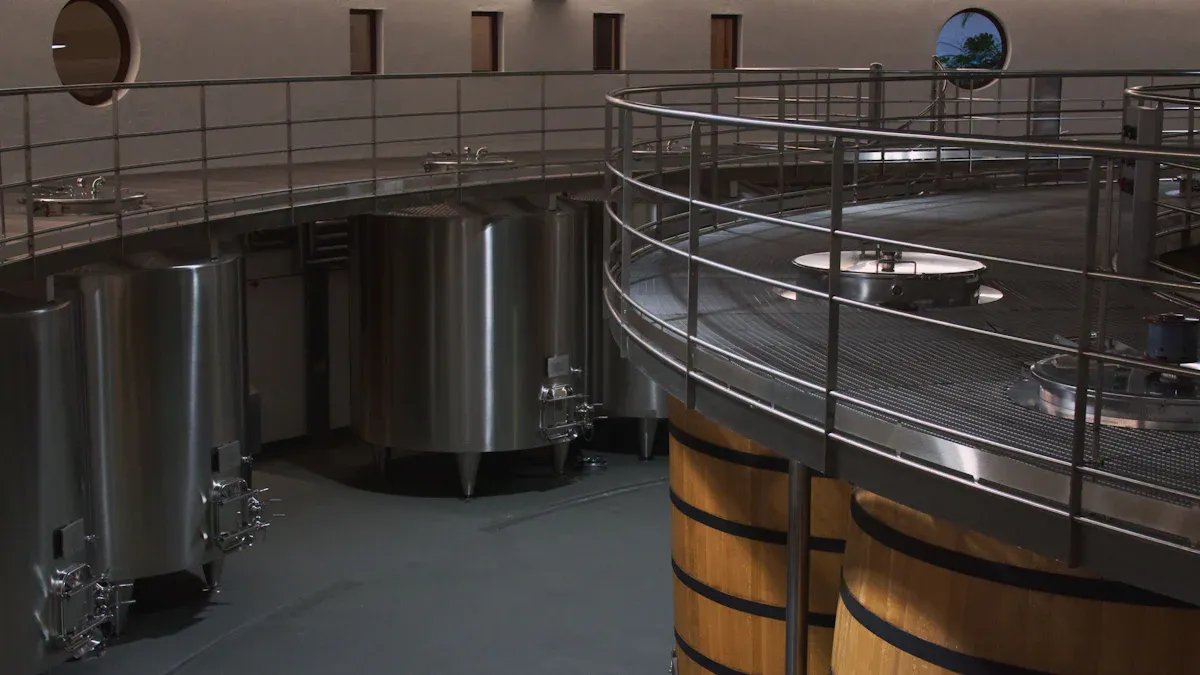
Durability and Longevity
Stainless steel wine tanks offer unmatched durability and longevity, making them a cornerstone of modern winemaking. You can rely on these tanks to resist corrosion, even when storing acidic wines. Their composition, which includes chromium and nickel, protects against rust and degradation, ensuring consistent performance for decades. Unlike wooden barrels, stainless steel does not warp, crack, or absorb moisture, which means you won’t have to worry about costly repairs or replacements.
These tanks are built to withstand extreme conditions. They can endure temperatures up to 700°C, making them versatile for various winemaking processes. Whether you’re fermenting, storing, or aging wine, stainless steel tanks maintain their integrity, even when left empty for extended periods. This long service life reduces operational costs over time, providing significant savings compared to materials like plastic or glass. While the initial investment may be higher, the cost-benefit analysis clearly favors stainless steel due to its durability and energy efficiency.
Easy to Clean and Maintain
Keeping your winemaking equipment clean is essential for producing high-quality wine, and stainless steel wine tanks make this process remarkably easy. Their non-porous surface resists damage during cleaning, ensuring that no residue or contaminants remain. You can sanitize these tanks efficiently without worrying about corrosion or wear. Comparative studies have shown that stainless steel performs better than materials like glass or nylon in maintaining hygienic properties after cleaning.
The smooth surface of stainless steel prevents the buildup of bacteria and other microorganisms, which is crucial for preserving the characteristic flavor of wine grapes. Cleaning processes are simplified, saving you time and effort. Additionally, stainless steel’s durability allows you to use sanitizers without compromising the tank’s integrity. This ease of maintenance ensures that your winery meets hygiene standards consistently, giving you peace of mind and helping you focus on crafting exceptional wine.
Flavor Neutrality for Authentic Wine Profiles
One of the key advantages of stainless steel wine tanks is their flavor neutrality. Unlike oak barrels, which impart additional flavors to the wine, stainless steel allows the natural characteristics of wine grapes to shine. You can preserve the authentic profile of your wine without interference from the storage material. This is especially important for winemakers who prioritize the purity and freshness of their product.
Stainless steel’s non-reactive nature ensures that no unwanted flavors or aromas alter the wine during fermentation or storage. This neutrality is ideal for producing wines with delicate notes, such as white wines or sparkling varieties. By using stainless steel, you can achieve consistent results that highlight the unique qualities of your grapes. This versatility and adaptability make stainless steel tanks a preferred choice for wineries aiming to produce high-quality, authentic wine.
Cost-Effectiveness for Wineries of All Sizes
Investing in stainless steel wine tanks offers significant cost advantages for wineries, whether you operate on a small or large scale. These tanks provide a long-term solution that minimizes expenses while maximizing efficiency. Their durability, low maintenance requirements, and versatility make them a smart financial choice for winemakers.
1. Long-Term Savings Through Durability
Stainless steel wine tanks are built to last. Their corrosion-resistant properties ensure they remain functional for decades, even when exposed to acidic conditions. Unlike wooden barrels, which require frequent replacement, stainless steel tanks eliminate recurring costs. You can rely on their strength and stability to reduce the need for repairs or replacements, saving money over time.
2. Reduced Maintenance Costs
Maintaining stainless steel tanks is straightforward and cost-effective. Their non-porous surface resists stains and microbial buildup, which simplifies cleaning. You can sanitize these tanks quickly without using expensive cleaning agents. This ease of maintenance not only saves time but also reduces operational costs, allowing you to allocate resources to other areas of your winery.
Tip: Regular cleaning of stainless steel tanks ensures optimal hygiene and preserves the characteristic flavor of wine grapes, helping you maintain consistent quality.
3. Scalability for Wineries of All Sizes
Whether you run a boutique winery or a large-scale operation, stainless steel tanks adapt to your needs. Their versatility and adaptability allow you to choose from a wide range of sizes and configurations. For small wineries, compact tanks provide an affordable entry point. For larger facilities, custom designs can optimize space and production capacity. This scalability ensures that stainless steel tanks remain a cost-effective option, regardless of your production volume.
4. Energy Efficiency and Operational Savings
Stainless steel tanks contribute to energy savings during the winemaking process. Their thermal conductivity allows precise temperature control, reducing energy consumption for heating or cooling. This efficiency lowers utility bills and minimizes environmental impact. Over time, these operational savings add up, making stainless steel tanks an economical choice for sustainable winemaking.
5. Value Retention and Resale Potential
Stainless steel tanks retain their value over time. If you decide to upgrade or change your equipment, you can resell these tanks at a competitive price. Their durability and high demand in the industry ensure a strong resale market. This value retention further enhances their cost-effectiveness, providing financial flexibility for your winery.
By choosing stainless steel wine tanks, you invest in a solution that balances upfront costs with long-term benefits. Their durability, low maintenance, and energy efficiency make them a practical choice for wineries aiming to optimize their budget without compromising quality.
Scientific Principles Behind Stainless Steel Fermentation Tanks
Corrosion Resistance and Its Impact on Hygiene
Stainless steel fermentation tanks excel in resisting corrosion, a critical factor in maintaining a hygienic and safe environment for winemaking. Corrosion can compromise the integrity of fermentation vessels, leading to contamination and affecting the purity of your wine. Stainless steel, particularly the 316L grade, contains molybdenum, which enhances its resistance to corrosion caused by sulfur compounds. This feature proves especially beneficial during white wine fermentation, where sulfur dioxide is often used as a preservative.
The hygienic properties of stainless steel fermentation tanks make them indispensable in the wine industry. During the fermentation process, residues from yeasts and acids accumulate on the tank’s surface. Unlike porous materials, stainless steel resists pitting and cracking, ensuring no residue seeps into the material. This resistance simplifies cleaning and prevents microbial growth, safeguarding the quality of your wine.
Note: Regular cleaning of stainless steel fermentation tanks not only preserves their corrosion resistance but also ensures a consistently hygienic environment for wine production.
Thermal Conductivity for Temperature Precision
Temperature control plays a pivotal role in the fermentation process, and stainless steel fermentation tanks offer unmatched precision in this area. The thermal conductivity of stainless steel allows you to regulate the temperature of the must efficiently. Built-in cooling jackets or external temperature-controlled systems work seamlessly with stainless steel, enabling you to maintain the ideal conditions for fermentation.
For example, during red wine fermentation, you may need to maintain higher temperatures to extract tannins and color from the grape skins. Conversely, white wine fermentation often requires cooler temperatures to preserve delicate aromas and flavors. Stainless steel fermentation tanks respond quickly to temperature adjustments, ensuring that the fermentation process remains consistent and predictable. This precision helps you craft wines with balanced profiles and exceptional quality.
Tip: Using temperature-controlled stainless steel fermentation tanks can reduce energy consumption, making your winemaking process more sustainable and cost-effective.
Non-Porous Surface for Enhanced Sanitation
The non-porous surface of stainless steel fermentation tanks provides a significant advantage in maintaining sanitation. Unlike materials like wood or concrete, stainless steel does not absorb liquids or harbor bacteria. This feature ensures that your fermentation vessels remain free from contamination, preserving the purity of your wine.
Cleaning stainless steel tanks is straightforward due to their smooth, non-porous surface. You can use standard sanitizing agents without worrying about damaging the material. This ease of cleaning reduces the risk of cross-contamination between batches, allowing you to produce consistent, high-quality wine. Additionally, the non-porous nature of stainless steel prevents the buildup of residues, such as tartaric acid crystals, which can interfere with the fermentation process.
Callout: By choosing stainless steel fermentation tanks, you invest in a solution that combines durability, hygiene, and ease of maintenance, ensuring your winery meets the highest standards of cleanliness.
Stainless Steel Wine Tanks vs. Traditional Materials
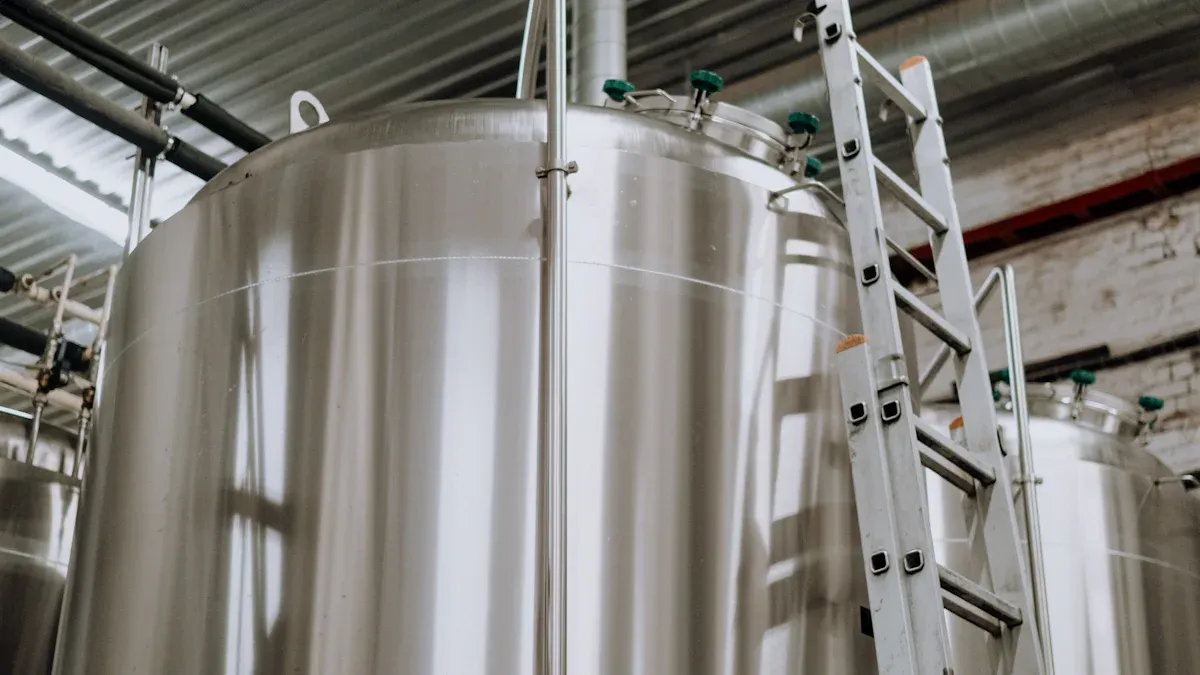
Comparing Stainless Steel and Oak Barrels
When comparing stainless steel wine tanks to oak barrels, you’ll notice distinct differences in their impact on winemaking. Stainless steel tanks preserve the natural flavors of the grapes, making them ideal for wines like Sauvignon Blanc or Riesling. Oak barrels, on the other hand, add unique flavors such as vanilla or spice, which enhance bold reds like Cabernet Sauvignon.
Stainless steel tanks excel in durability and maintenance. They resist corrosion and last over 20 years, while oak barrels typically need replacement every 3-5 years. Cleaning stainless steel is straightforward due to its smooth, non-porous surface. In contrast, oak barrels require more effort because their porous nature can trap residues.
| Feature | Stainless Steel Tanks | Oak Barrels |
|---|---|---|
| Flavor Impact | Neutral, preserves grape characteristics | Adds flavors like vanilla or spice |
| Durability | Over 20 years | 3-5 years |
| Maintenance | Easy to clean | Labor-intensive |
| Cost Effectiveness | Larger volume, long-term savings | Higher cost for smaller volumes |
Stainless Steel vs. Concrete: A Modern Alternative
Concrete tanks offer a rustic charm, but stainless steel provides unmatched precision and hygiene. Concrete’s porous surface allows micro-oxygenation, which can enhance texture in certain wines. However, this porosity also makes cleaning more challenging. Stainless steel’s non-porous surface ensures easy sanitation, reducing the risk of contamination.
Temperature control is another area where stainless steel outshines concrete. Stainless steel tanks often include cooling jackets, allowing precise temperature adjustments during fermentation. Concrete lacks this feature, making it harder to maintain consistent conditions. For modern wineries, stainless steel offers a practical and efficient solution.
Why Stainless Steel is the Preferred Choice for Winemakers
Stainless steel wine tanks have become the go-to choice for winemakers due to their versatility and reliability. Their inert nature ensures that the wine’s natural flavors remain unaltered. This makes them perfect for showcasing the purity of your grapes.
Durability is another key advantage. Stainless steel tanks resist wear and corrosion, providing a long service life. They also support sustainable practices, as they are recyclable and energy-efficient. With features like temperature control and easy cleaning, stainless steel tanks simplify the winemaking process while maintaining high-quality standards.
Tip: If you want to produce consistent, high-quality wine, stainless steel tanks offer the best combination of durability, hygiene, and precision.
The Role of Stainless Steel Fermentation Tanks in Modern Wineries
Applications in Small-Scale and Large-Scale Wineries
Stainless steel fermentation tanks cater to wineries of all sizes, offering flexibility and efficiency. For small-scale wineries, compact tanks provide an affordable solution without compromising quality. These tanks allow you to experiment with different wine styles, giving you the freedom to refine your craft. Their easy-to-clean design ensures that even small operations can maintain high hygiene standards.
In large-scale wineries, stainless steel tanks shine with their scalability and advanced features. You can choose from a variety of sizes and configurations to optimize production capacity. Many large wineries use custom tanks equipped with cooling jackets or automated systems to streamline the fermentation process. This adaptability makes stainless steel tanks a practical choice for wineries aiming to meet growing demand while maintaining consistent quality.
How Stainless Steel Supports Sustainable Winemaking
Sustainability plays a crucial role in modern winemaking, and stainless steel tanks contribute significantly to this goal. These tanks enhance energy efficiency during fermentation by enabling precise temperature control.
- Temperature management reduces energy consumption, especially in refrigeration systems.
- Wineries consume up to 90% of their electricity for cooling processes, including fermentation control.
- Efficient temperature regulation minimizes waste and lowers the environmental impact of winemaking.
By choosing stainless steel tanks, you support sustainability while reducing operational costs. Their durability also ensures a long service life, further decreasing waste and promoting eco-friendly practices.
Examples of Wineries Leveraging Stainless Steel Innovation
Andrew Cameron from Delegat’s Wine Estate Winery in New Zealand shared, “We have recently equipped our entire stainless steel winery (more than 300 tanks) with RFID tags. In the past, we always had the problem of having to keep handwritten records and manually type in the extensive lists of data into a spreadsheet. Many hours of data entry and re-sampling due to transcription errors have now been reduced due to automatic data handling.”
Cornish Enterprises in Napa, CA, developed a unique mobile sorting platform called the “Enterprise.” This platform stands fourteen feet above the fermentation floor and can be positioned over stainless steel tanks. It allows for precise sorting of freshly harvested grapes, ensuring gentle delivery into the fermenters.
These examples highlight how stainless steel tanks drive innovation, improving efficiency and quality in winemaking.
How Chenma Leads in Stainless Steel Wine Tank Manufacturing
Chenma’s Expertise in Custom Stainless Steel Tanks
Chenma stands out as a leader in manufacturing custom-sized and designed stainless steel wine tanks. Operating from a 20,000 m² state-of-the-art facility in Shandong Province, Chenma employs over 200 skilled professionals dedicated to crafting tanks tailored to your unique needs. Whether you require advanced temperature control systems or specific tank dimensions, Chenma’s team ensures precision and quality in every product.
The company’s ability to adapt to diverse winemaking requirements sets it apart. You can rely on Chenma for seamless installation services and comprehensive training programs, which help you optimize the use of your equipment. These custom solutions enhance your winemaking process, ensuring efficiency and consistency in every batch.
Certifications and Quality Standards of Chenma Products
Chenma’s commitment to the highest quality standards is evident in its certifications. The company has achieved ISO9001-2005 for quality management, ISO14001-2015 for environmental management, and OHSAS18001-2007 for occupational health management. These certifications reflect Chenma’s dedication to producing reliable and sustainable products.
| Certification/Standard | Description |
|---|---|
| ISO9001-2005 | Quality management system certification |
| ISO14001-2015 | Environmental management system certification |
| OHSAS18001-2007 | Occupational health management system certification |
| EU CE certification | Compliance with European safety standards |
These certifications ensure that Chenma’s tanks meet rigorous safety and environmental standards, giving you confidence in their performance and durability. By choosing Chenma, you invest in equipment that aligns with global benchmarks for quality and sustainability.
Real-World Applications of Chenma Stainless Steel Tanks
Chenma’s stainless steel tanks excel in real-world winemaking scenarios. Their precise temperature control supports optimal yeast activity, which is crucial for developing complex flavors. The tanks’ non-porous surface prevents contamination, maintaining the purity of your wine throughout fermentation and aging.
You can also use these tanks for bulk storage, as their corrosion resistance ensures the wine’s quality remains uncompromised. Additionally, their thermal conductivity reduces energy consumption, making them an eco-friendly choice. These features make Chenma’s tanks a reliable solution for wineries of all sizes, from boutique operations to large-scale facilities.
Tip: Chenma’s tanks not only enhance your winemaking process but also contribute to sustainable practices, reducing operational costs over time.
The Future of Stainless Steel in Winemaking
Trends in Modern Winemaking and Stainless Steel
The winemaking industry is embracing stainless steel as a cornerstone of modern practices. This shift is driven by the material’s durability, hygiene, and ability to maintain precise temperature control during fermentation. Stainless steel tanks have become essential for producing consistent, high-quality wine across various styles.
Several market trends highlight the growing importance of stainless steel in winemaking:
- The global market for stainless steel tank-aged wine is expected to grow from $483.6 billion in 2023 to $762.3 billion by 2032, with a CAGR of 5.2%.
- In Europe, the demand for stainless steel wine tanks is projected to rise at a CAGR of 5.8% from 2023 to 2028, driven by sustainability and efficiency.
- U.S. wineries are also adopting stainless steel solutions, with the market anticipated to reach $116.07 billion by 2030.
These trends reflect the increasing preference for stainless steel as wineries prioritize sustainability and operational efficiency.
Innovations in Stainless Steel Fermentation Technology
Advancements in stainless steel technology are transforming the fermentation process. Modern tanks now feature cutting-edge designs, such as built-in cooling jackets and automated systems, to enhance precision. These innovations allow you to maintain ideal conditions for fermentation, ensuring consistent results.
Manufacturers are also adopting eco-friendly practices, including the use of recycled materials and renewable energy sources. Closed-loop systems and energy-efficient production methods further reduce the environmental impact of stainless steel tanks.
Callout: Stainless steel’s versatility supports various wine styles, making it a valuable tool for both traditional and experimental winemaking techniques.
Meeting Consumer Demands with Stainless Steel Solutions
Consumers increasingly value sustainability in winemaking. Stainless steel solutions align with this trend by offering energy efficiency, durability, and low environmental impact. Wineries are adopting practices like reducing carbon footprints and minimizing water usage, which stainless steel tanks support effectively.
The demand for efficient, low-impact equipment continues to grow. By choosing stainless steel, you can meet these expectations while maintaining the quality and authenticity of your wine. This approach not only satisfies consumer preferences but also positions your winery as a leader in sustainable practices.
Why Stainless Steel Fermentation Tanks Are Easy to Clean
The Non-Porous Surface Advantage
Stainless steel fermentation tanks feature a non-porous surface that makes them easy to clean. Unlike materials like wood or concrete, stainless steel does not absorb liquids or harbor bacteria. This smooth surface prevents residue buildup, ensuring your tanks remain hygienic after every use. You can rely on this material to maintain the purity of your wine, as it resists contamination from previous batches.
The non-porous nature of stainless steel also simplifies the removal of tartaric acid crystals and other residues that form during fermentation. These deposits can interfere with the process if left unchecked. With stainless steel, you can clean your tanks thoroughly without worrying about damaging the material. This advantage ensures your equipment stays in top condition, supporting consistent wine production.
Tip: Regular cleaning of stainless steel tanks helps preserve their non-porous surface and ensures optimal hygiene for your winery.
Simplified Cleaning Processes for Wineries
Cleaning stainless steel fermentation tanks is straightforward and efficient. You can use standard sanitizing agents to remove residues without damaging the surface. The smooth design of these tanks allows you to clean them quickly, saving time and effort. This simplicity is especially beneficial for wineries that handle large production volumes.
Many stainless steel tanks come equipped with features like spray balls or automated cleaning systems. These tools distribute cleaning solutions evenly, ensuring every corner of the tank is sanitized. You can reduce labor costs and improve workflow by using these systems. Whether you operate a small winery or a large-scale facility, stainless steel tanks make cleaning a hassle-free process.
Maintaining Hygiene Standards with Stainless Steel
Maintaining hygiene standards is crucial in winemaking, and stainless steel fermentation tanks excel in this area. Their non-reactive surface prevents microbial growth, ensuring your wine remains uncontaminated. You can clean these tanks thoroughly between batches, eliminating the risk of cross-contamination.
Stainless steel’s durability also supports the use of strong sanitizers, which are essential for meeting industry hygiene standards. You can rely on these tanks to withstand repeated cleaning cycles without compromising their integrity. By choosing stainless steel, you ensure your winery maintains a clean and safe environment for wine production.
Callout: Stainless steel fermentation tanks combine durability and hygiene, making them a reliable choice for wineries focused on quality and safety.
Stainless wine fermenters combine scientific innovation with practical benefits, making them essential for modern winemaking. Their durability ensures long-term reliability, while their hygienic design supports consistent, high-quality production. These fermenters also maintain the natural flavors of wine, allowing you to craft authentic profiles without interference.
Studies validate these advantages.
| Study Title | Key Findings |
|---|---|
| Combination of Two Analytical Techniques Improves Wine Classification by Vineyard, Region, and Vintage | Identical fermentation and aging protocols in stainless steel vessels minimized variability, highlighting their importance in controlling wine quality. |
| Microbial Fermentation in Food and Beverage Industries: Innovations, Challenges, and Opportunities | The use of stainless-steel fermenters and precise measuring instruments significantly improved the control of fermentation processes. |
Additionally, stainless steel tanks dominate winemaking due to their unmatched benefits:
- They maintain the freshness of grapes.
- They do not transfer flavors to the wine.
- They provide excellent hygiene.
As winemaking evolves, stainless steel remains a cornerstone for sustainable and innovative practices. By choosing these fermenters, you ensure precision, efficiency, and a commitment to quality.
FAQ
1. Why are stainless steel tanks better than traditional materials for winemaking?
Stainless steel tanks resist corrosion and contamination. Their non-porous surface ensures easy cleaning and sanitation. Unlike oak barrels or concrete, they maintain the wine’s natural flavors without adding unwanted characteristics. You can rely on them for consistent, high-quality results.
2. How do stainless steel tanks help with temperature control during fermentation?
Stainless steel conducts heat efficiently. Cooling jackets or external systems allow precise temperature adjustments. This control ensures optimal fermentation conditions, preserving the wine’s aromas and flavors. You can craft wines with balanced profiles using this feature.
3. Are stainless steel tanks suitable for small wineries?
Yes! Stainless steel tanks come in various sizes. Compact designs fit small wineries perfectly. They offer affordability, easy maintenance, and scalability. You can experiment with different wine styles while maintaining hygiene and quality.
4. How long do stainless steel wine tanks last?
Stainless steel tanks last decades due to their durability. They resist corrosion and wear, even under acidic conditions. You won’t need frequent replacements, making them a cost-effective choice for long-term use.
5. Can stainless steel tanks support sustainable winemaking?
Absolutely! Stainless steel tanks reduce energy consumption with efficient temperature control. Their long lifespan minimizes waste. You can also recycle them, making them an eco-friendly option for wineries focused on sustainability.

